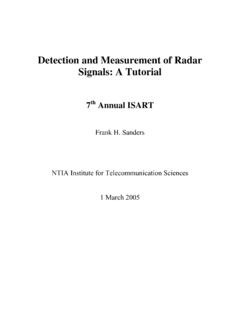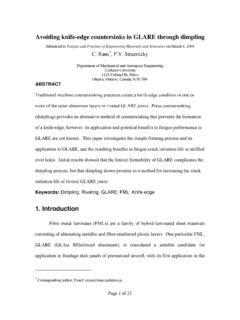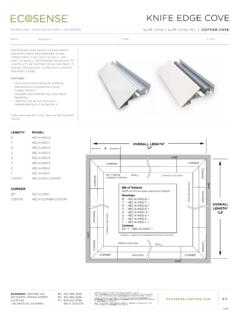Transcription of A Comparative Analysis of Multiple Knife-Edge Diffraction ...
1 A Comparative Analysis of Multiple Knife-Edge Diffraction MethodsNicholas DeMinco and Paul McKennaInstitute for Telecommunication BroadwayBoulder, Colorado 80305-3328303-497-3660 and and Analysis Effort The rigorous Diffraction loss computation algorithm for many Diffraction edges is very time consuming even with state-of-the art computers. A faster Diffraction loss computation algorithm for many Diffraction edges is needed for the short-range mobile-to-mobile propagation model. The rigorous Diffraction algorithm of Vogler has been verified to be extremely accurate when compared to measured data, but the run times for many edges are too excessive.
2 Need to find an alternative algorithm by comparing the accuracy of four faster Diffraction algorithms to the Vogler algorithm for many Diffraction loss scenarios with Multiple Analysis Effort Rigorous Vogler method with run times on the order of seconds on a PC, whereas alternative methods run in microseconds. PC based mobile-to-mobile propagation model under development will need to make Diffraction computations for many radials for interference and area predictions. If ray path from one edge to next is in transition zone and aligns too closely with incident shadow boundary, an error results in computation. In most cases this error is detectable, predictable and can be Alternative Diffraction Algorithms The Bullington Algorithm- simplest method to implement, but least accurate.
3 The Epstein/Peterson Algorithm-slightly more complex than Bullington algorithm, but with improved accuracy. The Deygout Algorithm-more complex than previous two algorithms, but with improved accuracy. The Giovaneli Algorithm-most complex to implement when compared to previous three algorithms, but with improved accuracy. The Bullington algorithm has been determined to be the least accurate Diffraction loss computation for many Multiple Analysis Approach All four of the alternative Diffraction algorithms are graphical techniques, and they are usually computed manually. Mathematical algorithms for each of the four alternative Diffraction algorithms were developed, so that they could be implemented in computer code and incorporated into the short-range mobile-to-mobile model.
4 The Diffraction algorithm that is selected must apply to all of the possible Diffraction edge geometries that can occur. Fifty different scenarios were tested against the four alternative algorithms for an initial attempt at simulation of many different scenarios. These scenarios included many variations of: varying distances between edges , different heights, and different ratios of heights-to-distances between edges over the range of frequencies. It was necessary to resurrect the Vogler Diffraction algorithm, which is a complex computation of Multiple summations and Multiple Vogler Method The knife - edges are assumed to be perfectly conducting screens placed normal to the direction of propagation extending to infinity in both directions and vertically downwards.
5 Vogler derived the Multiple Knife-Edge solution using Fresnel-KirchoffTheory. The expression for the Multiple Knife-Edge attenuation function is in the form of a Multiple integral, which is developed into a series which can be numerically evaluated. The terms of this series involve repeated integrals of the complementary error function. In the application of Fresnel-Kirchoff theory to Multiple Knife-Edge Diffraction , the elements of the wavefront are formed in the aperture above each Knife-Edge and the assumption is made that the field at any particularelement arises solely from the total field over the preceding aperture. The solution is a successive summation of all edgesGiovaneli all edgesEpstein/Peterson all edgesBullington all edgesCase Number Loss Difference (dB) Diffraction Loss Difference Comparison wrt Vogler-40-2002001020304050 Deygout all edgesGiovaneli all edgesEpstein/Peterson all edgesCase numberDiffraction Loss Difference wrt Vogler (dB) Diffraction Loss Difference Comparison wrt Vogler-40-2002001020304050 Deygout Big 3 Giovaneli Big 3 Epstein/Peterson Big 3 Loss Difference (dB)
6 Diffraction Loss Difference wrt Vogler-40-2002001020304050 Deygout no sub-path edgesGiovaneli no sub-path edgesEpstein/Peterson no sub-path edgesCase NumberLoss Difference (dB) Diffraction Loss Difference Comparison wrt Vogler-40-2002001020304050 Deygout ITU23 Deygout no sub-path edgesDeygout Big 3 Deygout All EdgesCase NumberLoss Difference (dB) Diffraction Loss Difference Comparison wrt Vogler-40-2002001020304050 Epstein Peterson Big 3 Epstein/Peterson no sub-path edgesEpstein/Peterson Big 3 CorrectedEpstein Peterson no sub-path edges correctedEpstein Peterson all edges correctedEpstein/Peterson all edgesCase NumberLoss Difference (dB) Diffraction Loss Difference Comparison wrt Vogler-40-2002001020304050 Epstein Peterson Big 3 Epstein/Peterson no sub-path edgesEpstein Peterson all edges correctedEpstein/Peterson all edgesCase NumberLoss Difference (dB)
7 Diffraction Loss Difference Comparison wrt Vogler-40-2002001020304050 Giovaneli no sub-path edgesGiovaneli Big 3 edgesGiovaneli all edgesCase NumberLoss Difference (dB) Diffraction Loss Difference wrt Vogler-40-2002001020304050 Giovaneli no sub-path edgesDeygout no sub-path edgesDeygout ITU23 Epstein/Peterson no sub-path edgesEpstein/Peterson all edges correctedCase NumberLoss Difference (dB) Diffraction Loss Difference Comparison wrt Vogler-20-10010203001020304050 Giovaneli no sub-path edgesDeygout no sub-path edgesDeygout ITU23 Epstein/Peterson no sub-path edgesEpstein/Peterson all edges correctedCase NumberLoss Difference (dB) Diffraction Loss Difference Comparison wrt Vogler0204060801000246810 EPALLEPALLCDGB3 ITUDGALLDGB3 GVALLV oglerGTDD iffraction Angle (mrad) Diffraction Loss (dB)Comparison of Diffraction Algorithms With Vogler Algorithm for Five Equally Spaced edges and Equal Diffraction Angles0204060801000246810 EPALLDGB3 ITUGVALLV oglerDiffraction Angle (mrad) Diffraction Loss (dB)Comparison of Diffraction Algorithms With Vogler Algorithm for Five Equally Spaced edges and Equal Diffraction Angles0204060801000246810 EPALLEPALLCV oglerDiffraction Angle (mrad) Diffraction Loss (dB)
8 Comparison of Diffraction Algorithms With Vogler Algorithm for Five Equally Spaced edges and Equal Diffraction Angles0204060801000246810 DGB3 ITUDGALLDGB3 VoglerDiffraction Angle (mrad) Diffraction Loss (dB)Comparison of Diffraction Algorithms With Vogler Algorithm for Five Equally Spaced edges and Equal Diffraction Angles0204060801000246810 GVALLV oglerGTDD iffraction Angle (mrad) Diffraction Loss (dB)Comparison of Diffraction Algorithms With Vogler Algorithm for Five Equally Spaced edges and Equal Diffraction AnglesResults It was found by Comparative computations that removing the sub-path obstacles improves agreement between the Deygout method and the Vogler method, but degrades the Epstein/Peterson method s agreement with the Vogler method.
9 Comparative computations show that the Deygout method achieves better agreement with the Voglermethod when only the major three edges are included in the computation of Diffraction loss. Further investigations of different geometric configurations representing additional Diffraction scenarios will be run comparing the alternative methods with the Vogler When a ray path from one edge to the next consecutive edge is in the transition region and near the incident or reflection shadow boundary, the alternative methods fail to compute the Diffraction loss correctly. Computation of these ray-path angles and shadow boundaries confirm this.
10 The procedure and order of computing edge Diffraction loss is different for each of the alternative methods investigated. As a result, for the same Diffraction scenario, one method may avoid alignment of the ray path with the incident shadow boundary, and another may align the ray path with the incident shadow boundary. The method that avoids this alignment will predict the Diffraction loss with better accuracy, if the deviation of the ray path is large enough. An approach under study for selecting a Diffraction method that achieves better accuracy is to use one method that has the largest deviation between the ray path and the incident shadow boundary.












